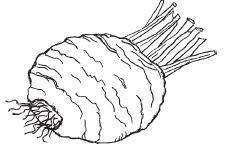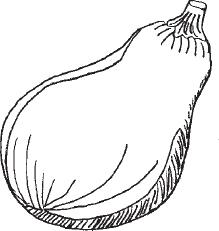Nourishing Traditions: The Cookbook That Challenges Politically Correct Nutrition and The... (112 page)
Authors: Sally Fallon,Pat Connolly,Phd. Mary G. Enig
Tags: #Non-Fiction, #Reference, #Science, #Health
Potatoes Gratin
Serves 4-6
3 large baking potatoes, washed but not peeled
2 cups
beef stock1 cup
piima cream
or
creme fraiche1 teaspoon butter
sea salt and pepper
1 clove garlic, peeled and minced
While Americans think that potatoes "au gratin" means potatoes in casserole with cheese, the dish is traditionally made only with milk or stock and
creme fraiche
.Slice potatoes into the stock and bring to a boil. Cook, stirring almost constantly, for about 10 minutes. Meanwhile, butter a 9-inch by 9-inch glass oblong pan and sprinkle bottom with sea salt, pepper and minced garlic. Remove the potato slices with a slotted spoon and arrange them randomly in the casserole. Bring the cream to a boil, pour into the stock and boil the two together for a minute. Pour over potatoes. Bake at 350 degrees about 1 hour more until the liquid has evaporated and the top has turned golden. You may reduce heat to 250 degrees and cook another hour or so if the casserole seems too liquid.
The absence or presence of additives alone does not determine the quality of food. The fundamental secret of quality production is to handle the plants and animals so that they attain their highest performance by their own nature. In each creation, there is an inner harmony of substances and forces that is typical and healthy. It is not the presence of certain substances in certain amounts that makes a vegetable or grain healthy; rather, it is the harmonious relationship between the substances and the forces.
To a large extent, modern agricultural methods have drastically affected this harmony. As research has shown, between 1896 and 1932 many crops exhibited a strong rise in the content of potash while their magnesium content declined. Meanwhile, other research shows that the silica content in cultivated plants has tended to decline while the potash content has been rising.
The results of this change to a less harmonious balance showed up in Eastern Europe, where for hundreds of years people thatched their roofs with rye straw. Those roofs typically lasted for fifteen years. But after the rye crops were treated with synthetic nitrogen, and the natural harmony of substances and forces had been altered, the roofs fashioned from the resulting straw began to rot after just three to five years. Though perhaps not so obvious, similar changes have occurred in the bread grain that is a staple of our diet. . .. Some observers believe the high phosphorous content in many processed foods. . .is a major factor in problems of hyperactive children, and other observers believe that the reduced silica content has led to a dulling of our senses. Trauger Groh and Steven McFadden
Farms of Tomorrow Revisited
Potato Quarters
Serves 4
4 large potatoes, washed but not peeled, cut into ¼-inch cubes
¼ cup melted butter
¼ cup extra virgin olive oil
1 teaspoon sea salt
½ teaspoon pepper
Toss potato cubes in butter, olive oil, salt and pepper. Place in a well-oiled stainless steel baking pan. Bake at 450 degrees until bottoms are crisp, then turn occasionally until desired crispness is obtained. Serve with a meat dish or as a snack. May be eaten plain or with
cultured cream
,
yoghurt
or naturally sweetened
ketchup
.
Potato and Celery Root Puree
Serves 8 to 10
6 baked
potatoes3 celery roots, peeled and cut up
2 cloves garlic, peeled and mashed
pinch nutmeg
sea salt and pepper
½ cup butter
½ to 1 cup
piima cream
or
creme fraiche
This beats plain old mashed potatoes any day. Cover the celery root pieces with cold water, bring to a boil and cook until very tender, about 30 minutes. Cut up the butter and place in the bottom of a large bowl. Scoop out potato flesh into the bowl. (Save the skins for
potato skins
.) Add the celery root and garlic, and mash all together. Add the cream to obtain desired consistency. If you want your puree really smooth, you may now mix with a handheld beater. Season to taste. Transfer to a buttered ovenproof dish and keep warm in the oven.
Myth: | To avoid heart disease, we should use margarine instead of butter. |
Truth: | Margarine eaters have twice the rate of heart disease as butter eaters. ( |

Potato Pancakes
Serves 6
6 baking potatoes, washed but not peeled
1 tablespoon sea salt
3-4 tablespoons whey
Whey and Cream Cheese
or lemon juice2 medium onions, grated
2 eggs, lightly beaten
¾ cup spelt or unbleached white flour
sea salt and pepper
3 tablespoons butter
3 tablespoons extra virgin olive oil
Grate potatoes in a food processor. Cover with water and stir in salt and whey or lemon juice. Cover and leave at room temperature about 7 hours. Meanwhile, mix grated onions with eggs and flour and season to taste. Rinse the potatoes in a colander, squeeze dry with a tea towel and stir into batter. Use a ¼-cup measure to scoop batter for pancakes. Saute on both sides in a mixture of butter and olive oil.
If a woman could see the sparks of light going forth from her fingertips when she is cooking and the substance of light that goes into the food she handles, she would be amazed to see how much of herself she charges into the meals that she prepares for her family and friends.
It is one of the most important and least understood activities of life, that the radiation and feeling that go into the preparation of food affect everyone who partakes of it, and this activity should be unhurried, peaceful and happy. It would be better that an individual did not eat at all than to eat food that has been prepared under a feeling of anger, resentment, depression or any outward pressure, because the substance of the lifestream performing the service flows into that food and is eaten and actually becomes part of the energy of the receiver. That is why the advanced spiritual teachers of the East never eat food prepared by anyone other than their own chelas. Conversely, if the one preparing the food is the only one in the household who is spiritually advanced and an active charge of happiness, purity and peace pours forth into the food from him, this pours forth into the other members and blesses them. I might say that there are more ways than one of allowing the Spirit of God to enter the flesh of man. Maha Chohan
Electrons
AMTF, PO Box 466, Mount Shasta, CA 96067
SPAGHETTI SQUASH
This unusual vegetable is a good substitute for pasta. Cut in half lengthwise, remove seeds and place cut sides down in a baking pan filled with about ½ inch of water. Bake at 350 degrees for about 1 hour or until tender. Let cool slightly and remove the "strands" bit by bit with a fork. Garnish with butter and a little Parmesan cheese or any one of a number of sauces, such as
pesto
or
tomato sauce
. The strands may also be formed into patties and sauteed in butter.
The body probably needs both animal and vegetable fats to maintain sound health. A study conducted among boys of Ruanda, Africa, a vegetarian population by necessity, found that carotene absorption by children was dependent upon the amount of fat in the diet, not the amount of carotene eaten. It was also established that a lowfat intake results in poor absorption of both carotenoids and preformed vitamin A. When small amounts of [animal] fat were added to their vegetarian diet, improvement in the absorption of carotene resulted and vitamin A levels increased. H. Leon Abrams
Vegetarianism: An Anthropological/Nutritional Evaluation

Spaghetti Squash Casserole
Serves 4
1 large spaghetti squash, prepared as above
2 medium onions, chopped
4 tablespoons extra virgin olive oil
2 ripe tomatoes, peeled, seeded and chopped
2 cloves garlic, peeled and chopped
½ teaspoon dried thyme
2 tablespoons fresh basil leaves, cut up
sea salt and pepper
¼ cup parsley, chopped
1 cup whole grain bread crumbs
½ cup freshly grated Parmesan cheese
2 tablespoons melted butter
To peel tomatoes, see
Kitchen Tips and Hints
. Saute onion in olive oil until soft. Add tomato, garlic, thyme and basil and cook gently until most of the liquid is absorbed. Mix with spaghetti squash, season to taste and pour into a well-buttered pyrex dish. Mix parsley, bread crumbs and Parmesan cheese and spread on top. Drizzle with melted butter. Bake, uncovered, at 350 degrees for about ½ hour or until most of the liquid is absorbed.
Even though calcium is present in spinach, children cannot utilize it. Data have been published showing that children absorb very little of the calcium or phosphorus in spinach before six years of age. Adult individuals vary in the efficiency with which they absorb minerals and other chemicals essential for mineral utilization. It is possible to starve for minerals that are abundant in the foods eaten because they cannot be utilized without an adequate quantity of the fat-soluble activators. Weston Price, DDS
Nutrition and Physical Degeneration
SPINACH
In general, one bunch of spinach or one bag will serve three persons. Cut stems off leaves and wash well in filtered water—even if prewashed, the leaves should be rinsed so that they are moist. Place in a large pot. Do not add more water to the pot as the water adhering to the leaves will be sufficient to steam the spinach. Cover pot and place over a medium flame. When spinach begins to simmer, reduce heat. Cook several minutes or until leaves are just wilted. Using a slotted spoon, transfer to a heated serving bowl. Press with the back of the spoon to squeeze out any liquid and pour out. Make a few cuts through the spinach and top with a generous pat of butter.